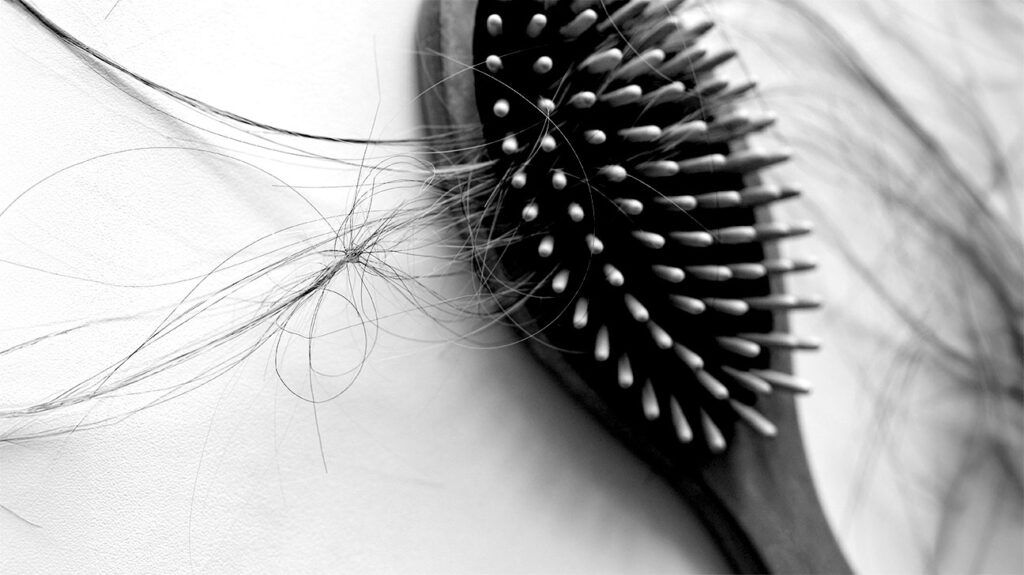The main telogen effluvium symptom is an increase in the amount of hair a person sheds. It is a form of temporary hair loss that usually happens after stress, a shock, or a traumatic event. The condition is generally reversible.
Telogen effluvium is
Telogen effluvium usually occurs on the top of the scalp. Chronic telogen effluvium refers to frequent periods of hair shedding over several months.
This article looks at the causes, symptoms, diagnosis, and treatment of telogen effluvium, including dietary changes that may help.

Telogen effluvium is a form of hair loss that involves hair thinning or increased hair shedding. It occurs
The hair cycle typically has three phases:
- Anagen or growth phase.
- Catagen or transitional phase.
- Telogen or resting phase.
Telogen effluvium is associated with the telogen phase. Typically, 5–10% of a person’s hair is in the telogen phase at any one time.
With telogen effluvium, the anagen phase slows down, meaning fewer hairs enter the next two stages. With this condition, around 30% of hair follicles move into the telogen phase, meaning hair shedding occurs.
Chronic telogen effluvium is where a person frequently experiences periods of hair shedding for
People with this condition do not lose all their hair, although it may become noticeably thin.
The main symptom of telogen effluvium is an increase in the amount of hair a person sheds.
Someone may notice more hair than usual falling out when washing or brushing it. They may also find more hair in the drain or on their pillow.
Disturbances to the hair cycle can be due to several triggers, including:
- Severe stress: Prolonged periods of stress can result in telogen effluvium. Hair loss typically occurs about
3 months after the stressful event. - Less nutritious diet: Hair requires key nutrients to grow, including protein, iron, B vitamins, and zinc.
- Sudden weight loss: Weight loss or chronic calorie restriction, such as in anorexia nervosa, can cause the hair to shed.
- Pregnancy and childbirth: During pregnancy, more hair is in the growth phase for longer. Hormonal changes that occur 3–4 months after birth can cause hair to shed, known as postpartum telogen effluvium.
- Menopause: Hormonal changes that occur during menopause may also cause telogen effluvium.
- Certain drugs: Certain medications and recreational drugs can cause hair loss.
- Underlying health conditions: These can include autoimmune disease, conditions that affect the thyroid gland, and alopecia areata.
- Surgery: This depends on the type of procedure, length of stay in the hospital, medications, and overall nutritional status.
- Metal toxicity: Contact with toxic chemicals in metal can lead to hair loss.
Treatment for telogen effluvium depends on what is triggering the hair loss. Once the trigger has been established and addressed, the hair cycle should stabilize, and hair will begin to grow back.
Treatment options include:
- addressing nutritional deficiencies through diet
- nonsurgical hair replacement
- hormone replacement therapy for people experiencing menopause
- counseling support to manage stress or anxiety
A person may wish to avoid chemical or heat treatments that could damage the hair. It is also advisable to avoid heat styling and heat treatment, such as curling or perming the hair.
Dietary considerations include:
- Getting enough protein: Protein provides the building blocks for hair to grow. A person can aim to include plenty of protein-rich foods such as meat, eggs, fish, beans, grains, and nuts. The amino acid lysine may be particularly important for hair growth.
- Getting enough iron: Iron deficiency
may have a connection with telogen effluvium. Making changes to the diet to include iron-rich foods may help with hair loss. These include red meat, liver, dark green leafy vegetables, beans, and lentils. - Using supplements: A person can consider supplementation for a short time while working on increasing their nutrition.
For professional advice, a person can contact a dermatologist or trichologist, who is a specialist in conditions related to the hair and scalp.
With telogen effluvium, it is common for hair to grow back
When diagnosing telogen effluvium, a doctor will examine the hairs that have fallen out. The diameter and length of the lost hairs can signal this condition and may help a doctor differentiate between telogen effluvium and alopecia.
A doctor can also perform
- A hair pull test to check how much hair a person is shedding.
- A wash test, which involves counting the number of hairs lost during washing.
- A blood test may also be useful to help determine the cause of hair loss. These tests can help diagnose iron deficiency or thyroid insufficiency.
A dermatologist might also be able to diagnose telogen effluvium and offer advice. They will look at other indicators of hair health, such as the appearance of the scalp, any patches of hair loss, or more generalized hair thinning.
Telogen effluvium is a common cause of temporary hair loss. It involves an abrupt onset of hair shedding, usually several months after experiencing a triggering event.
It usually lasts
